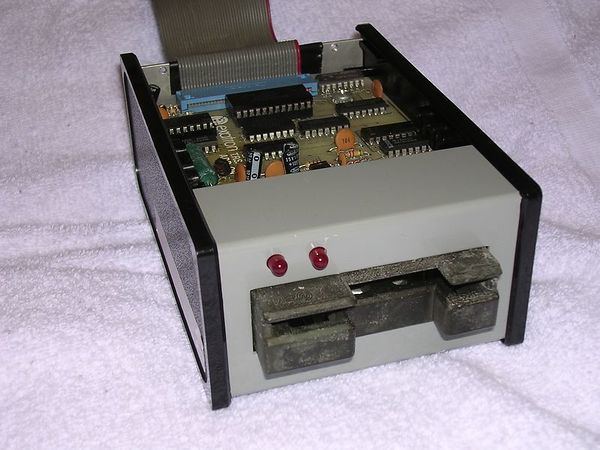 | ||
The Exatron Stringy Floppy (or ESF) is a continuous loop tape drive developed by Exatron.
The company introduced an S-100 stringy floppy drive at the 1978 West Coast Computer Faire, and a version for the Radio Shack TRS-80 in 1979. Exatron sold about 4,000 TRS-80 drives by August 1981 for $249.50 each, stating that it was "our best seller by far". The tape cartridge is about the size of a business card, but about 3⁄16 inch (4.8 millimetres) thick. The magnetic tape inside the cartridge is 1⁄16 inch (1.6 millimetres) wide. There is no single catalog of files; to load a specific file the drive searches the entire tape, briefly stopping to read the header of each found file. The tape loop only moves in one direction, so a file that starts behind the current location cannot be read until the drive searches the entire loop for it.
According to Embedded Systems magazine, the Exatron Stringy Floppy uses Manchester encoding, achieving 14K read-write speeds and the code controlling the device was developed by Li-Chen Wang, who also wrote a Tiny BASIC, the basis for the TRS-80 Model I Level I BASIC.
In the July 1983 issue of Compute!'s Gazette the Exatron Stringy Floppy for the Commodore VIC-20 and the 64 was reviewed. Calling the peripheral "a viable alternative" to tape or disk, the magazine noted that "under ideal conditions, a Stringy Floppy can outperform a VIC-1540/1541 disk drive". Texas Instruments licensed the Stringy Floppy as the Waferdrive for its TI 99/2 and CC-40 computers.
Exatron pitched the ESF as "The viable alternative". The ESF was faster and more reliable than a data cassette, and half the price of a floppy disk.
Cartridges, or "wafers", were available with tape lengths ranging from 5 to 75 feet. Known data capacities/tape length are: 4 kB/5 feet, 16 kB/20 feet, 48 kB/50 feet, and 64 Kk/75 feet. One complete cycle through a 20-foot tape takes 55 to 65 seconds, depending on the number of files on it.
